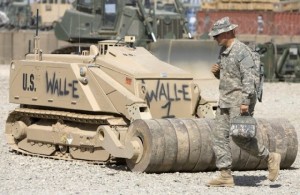
Our present-day pilotless platforms have been branded “drones” to their detriment. The word communicates a lack of adaptability or agency. For an increasingly automated fleet of machines, it denotes monotony and mindlessness: the droning of engines as a Predator lazily loops above the mountains, observing friend and foe alike. “Drone” is inappropriate for an ever-expanding suite of devices with greater close-in roles in combat. An AlphaDog, an EOD bomb-disposal bot, the DARPA Crusher, and the Battlefield Extraction Assistance Robot (BEAR) are not “drones.” To better describe our new combat compatriots and better comprehend their multitudinous uses and designs, let us properly christen our autonomous allies.
ComBot is the accurate alternative to “drone.” An obvious combination of Combat and Robot, it describes our soon-to-be automated assault associates in an easy-to-digest term. The name has a practicality lacking in most military monikers. It is not a shoe-horned acronym such as Close-In Weapons System (CIWS) pronounced “see-wiz” rather than “ki-wis” or “cue-z”. What layman would ever think of a high-tech Gatling-gun when they hear “CIWS”, or a pilotless aircraft when they hear “UAV”? However, the wordplay of ComBot makes the backing concept immediately recognizable. A rose by any other name may be just as sweet, but people abandoned the term horseless carriage for a reason; let’s update our language to match the concept.
Matt Hipple is a surface warfare officer in the U.S. Navy. The opinions and views expressed in this post are his alone and are presented in his personal capacity. They do not necessarily represent the views of U.S. Department of Defense or the U.S. Navy.
